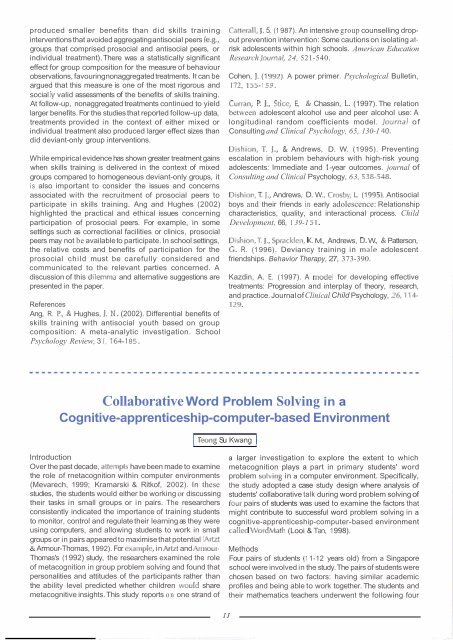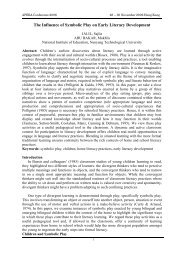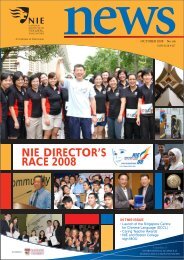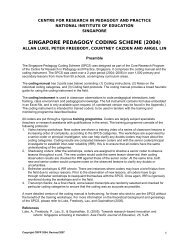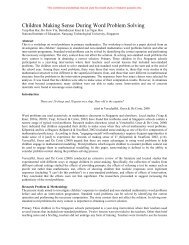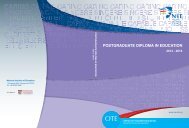Future EBuczttIomI Research: The - NIE Digital Repository - National ...
Future EBuczttIomI Research: The - NIE Digital Repository - National ...
Future EBuczttIomI Research: The - NIE Digital Repository - National ...
You also want an ePaper? Increase the reach of your titles
YUMPU automatically turns print PDFs into web optimized ePapers that Google loves.
produced smaller benefits than did skills traininginterventions that avoided aggregating antisocial peers (e.g.,groups that comprised prosocial and antisocial peers, orindividual treatment). <strong>The</strong>re was a statistically significanteffect for group composition for the measure of behaviourobservations, favouring nonaggregated treatments. It can beargued that this measure is one of the most rigorous andsocial Iy valid assessments of the benefits of skills training.At follow-up, nonaggregated treatments continued to yieldlarger benefits. For the studies that reported follow-up data,treatments provided in the context of either mixed orindividual treatment also produced larger effect sizes thandid deviant-only group interventions.While empirical evidence has shown greater treatment gainswhen skills training is delivered in the context of mixedgroups compared to homogeneous deviant-only groups, itis also important to consider the issues and concernsassociated with the recruitment of prosocial peers toparticipate in skills training. Ang and Hughes (2002)highlighted the practical and ethical issues concerningparticipation of prosocial peers. For example, in somesettings such as correctional facilities or clinics, prosocialpeers may not be available to participate. In school settings,the relative costs and benefits of participation for theprosocial child must be carefully considered andcommunicated to the relevant parties concerned. Adiscussion of this dilemma and alternative suggestions arepresented in the paper.ReferencesAng, R. P., 8r Hughes, J. N.(2002). Differential benefits ofskills training with antisocial youth based on groupcomposition: A meta-analytic investigation. SchoolPsychology Review, 3 I , 144-185. Catterall, J. 5. (1 987). An intensive group counselling dropoutprevention intervention: Some cautions on isolating atriskadolescents within high schools. American Education<strong>Research</strong> journal, 24, 521-540.Cohen, 1. (1992).A power primer. Psychological Bulletin,172, 155-159.Curran, P. I., Stice, E., & Chassin, L. (1997). <strong>The</strong> relationbetween adolescent alcohol use and peer alcohol use: Alongitudinal random coefficients model. lournal ofConsulting and Clinical Psychology, 65, 130-1 40.Dishion, T. I., & Andrews, D. W. (1995). Preventingescalation in problem behaviours with high-risk youngadolescents: Immediate and 1 -year outcomes. journal ofConsulting and Clinical Psychology, 63, 538-548.Dishion, T. I., Andrews, D. W., Crosby, L. (1995).Antisocialboys and their friends in early adolescence: Relationshipcharacteristics, quality, and interactional process. ChildDevelopment, 66, 1 39-1 51.D. &Dishion,T, J., Spracklen, K. M., Andrews, W., Patterson,G. R. (1996). Deviancy training in male adolescentfriendships. Behavior <strong>The</strong>rapy, 27, 373-390.Kazdin, A. E. (1997). A model for developing effectivetreatments: Progression and interplay of theory, research,and practice. Journal ofClinical Child Psychology, 26,114-129.Collaborative Word Problem Solving in aCognitive-apprenticeship-computer-based EnvironmentI Teong Su KwangIIntroduction Over the past decade, attemptshave been made to examinethe role of rnetacognition within computer environments(Mevarech, 1999; Kramarski & Ritkof, 2002). In thesestudies, the students would either be working or discussingtheir tasks in small groups or in pairs. <strong>The</strong> researchersconsistently indicated the importance of training studentsto monitor, control and regulate their learning as they wereusing computers, and allowing students to work in smallgroups or in pairs appeared to maximise that potential (Artzt81 Armour-Thomas, 1992). For example, in Artrt and Armour-Thomas's (1992) study, the researchers examined the roleof metacognition in group problem solving and found thatpersonalities and attitudes of the participants rather thanthe ability level predicted whether children wouId sharemetacognitive insights. This study reports on one strand ofa larger investigation to explore the extent to whichmetacognition plays a part in primary students' wordproblem solving in a computer environment. Specifically,the study adopted a case study design where analysis ofstudents' collaborative talk during word problem solving offour pairs of students was used to examine the factors thatmight contribute to successful word problem solving in acognitive-apprenticeship-computer-based environmenttailed WordMath (Looi & Tan, 1998).MethodsFour pairs of students (11-12 years old) from a Singaporeschool were involved in the study. <strong>The</strong> pairs of students werechosen based on two factors: having similar academicprofiles and being able to work together. <strong>The</strong> students andtheir mathematics teachers underwent the following four


